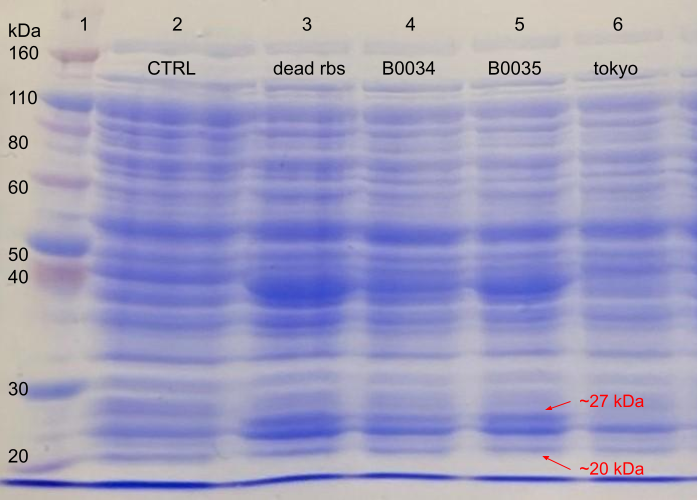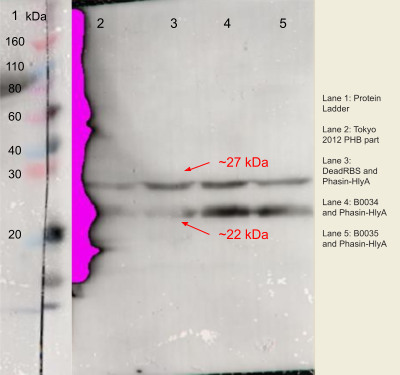Part:BBa_K4437501
DeadRBS-FLAG-phasin-HlyA (E. coli)
Usage and Biology
Phasin is an intracellular protein native to PHB-producing bacteria, which coats and stabilises polyhydroxybutyrate (PHB) granules in the bacterial cytoplasm, preventing the aggregation of the newly formed polymer [1]. By adding the C-terminus of the HlyA gene to the end of the phasin molecule, the resulting HlyA-tagged phasin molecule -- and the PHB granules to which it is bound -- can be secreted via the single-step Type I secretion system (TISS) in gram-negative bacteria [2]. Building upon the University of Calgary 2017 team’s BBa_K2260002, this part was produced by substituting the original RBS (BBa_B0034) for an RBS which results in only trace expression levels (BBa_K4437500). This part can be used as a negative control and as a means to test relative phasin-HlyA expression, and the subsequent yield of secreted PHB, of significantly stronger RBS alternatives.
Design
Using the original FLAG-phasin-HlyA part (BBa_K2260002) as a template, the B0034 (BBa_B0034) RBS was substituted with the DeadRBS (BBa_K4437500) RBS. The restriction enzyme cut sites for BstAPI and BstBI were also added, making the part compatible for digestion and ligation into the Tokyo Tech 2012 team’s BBa_K934001 plasmid for PHB expression assays. The FLAG protein allows for facilitated purification, and for characterization assays such as the Western blot.
Figure 1. An overview of the BBa_K4437501 construct map.
Sequence and Features
- 10COMPATIBLE WITH RFC[10]
- 12COMPATIBLE WITH RFC[12]
- 21COMPATIBLE WITH RFC[21]
- 23COMPATIBLE WITH RFC[23]
- 25COMPATIBLE WITH RFC[25]
- 1000COMPATIBLE WITH RFC[1000]
Characterization
<p> We have successfully amplified the DeadRBS-FLAG-phasin-HlyA part, ligated it into the PHB (BBa_K934001) plasmid, and transformed and expressed this plasmid in TOP10 E. coli cells. These preliminary confirmations were performed with restriction digests and diagnostic gel electrophoresis. This recombinant DNA was also successfully transformed into BL21 (DE3) E. coli cells and characterized on an SDS-PAGE using anti-FLAG antibodies. Future directions for the characterization of this part include sequencing, and the in-vitro PHB production assays will be used to quantify resulting yields of secreted PHB.
Figure 2. Agarose electrophoresis of purified DNA. Lane 1 contains a 2log 1000bp ladder. Lanes 20-24 contain the DeadRBS-FLAG-phasin-HlyA insert in the BBa_K934001 plasmid, transformed in and purified from BL21 E. coli. Lane 20 indicates banding at the anticipated range of approximately 7100bp, indicating the successful insertion and transformation of the BBa_K4437502 insert.
Figure 3. The expression of RBS-FLAG-phasin-hlyA with varying RBS strengths from the PHB construct (BBa_K934001) from BL21 (DE3) E.coli strain autoinduced for 24 hours. The process was visualised using 10% SDS-PAGE in 100V for 20 minutes and 180V for 40 minutes. The gel was stained with Coomassie blue. The gel was loaded as follows: (1) Ladder, (2) Lanmodulin positive control (BBa_K3945001), (3) Dead RBS upstream of phasin-Hlya in PHB construct (BBa_K4437501), (4) B0034 RBS upstream of phasin-Hlya in PHB construct (BBa_K226003), (5) B0035 upstream of phasin-Hlya in PHB construct (BBa_K4437502), (6) Tokyo 2012 PHB construct only (BBa_K934001).
Figure 4. The expression of phasin-hlyA with varying RBS strengths from the PHB construct (BBa_K934001) from BL21 (DE3) E. coli strain autoinduced for 48 hours on an SDS page using Anti-FLAG antibodies and the complementary capture antibody. The process was visualised using 10% SDS-PAGE in 100V for 20 minutes and 180V for 40 minutes. The gel was loaded as follows: (1) Ladder; (2) Tokyo 2012 PHB construct only (BBa_K934001); (3) B0034 RBS upstream of phasin-HlyA in PHB plasmid (BBa_K4437500); (4) B0034 RBS upstream of phasin-HlyA in PHB construct (BBa_K226002); (5) B0035 upstream of phasin-Hlya in PHB construct (BBa_K4437504).
References
1. Brown B, Immethun C, Wilkins M, Saha R. Biotechnical applications of phasins: Small proteins with large potential. Renewable and Sustainable Energy Reviews. 2022 Apr 1;158:112129.
2. Thomas S, Holland IB, Schmitt L. The Type 1 secretion pathway — The hemolysin system and beyond. Biochimica et Biophysica Acta (BBA) - Molecular Cell Research. 2014 Aug 1;1843(8):1629–41.
| None |




